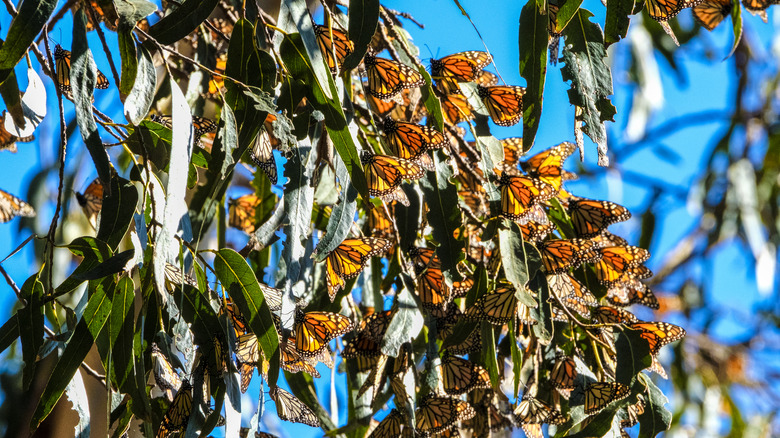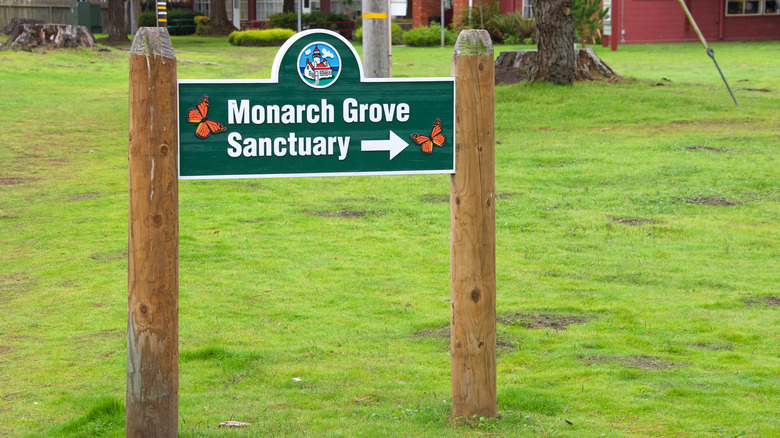This Lush Coastal California Sanctuary Is Perfect For Viewing A Magical Butterfly Migration
Close your eyes and imagine standing in a grove of eucalyptus and coastal pine trees. Breathe in the minty-wood aroma of eucalyptus mixed with the frost-like scent of pine wafting through the morning chill. Overhead and all around you, branches shimmer, flickering in autumn hues that seem to breathe, pulsing ever so gently. A faint rustling rises like a distant rainfall — not from wind or water, but from the delicate, collective flutter of butterfly wings. You're surrounded by thousands of monarchs, those iconic orange-and-black, migrating arthropods long recognized as symbols of transformation, growth, and even justice. They cluster here in the trees of the Pacific Grove Monarch Butterfly Sanctuary on California's Monterey Peninsula — and they come every year.
Each winter, monarch butterflies migrate from colder climates to "overwinter" in a hibernation-like state known as "diapause." On the West Coast, they trek from Canada as far south as San Clemente in southern California, creating the opportunity to drive the Western Monarch Trail — an epic road trip through a handful of California monarch sanctuaries (East Coast monarchs make their way to Mexico). For nearly a century, thousands of butterflies have stopped annually in Pacific Grove. So many monarchs used Pacific Grove as a wintering site that this coastal city earned the nickname "Butterfly Town, U.S.A.," and a dedicated sanctuary was established, operated by the Pacific Grove Museum of Natural History. The site's open year-round, but from October until February, it becomes a true butterfly wonderland. Wooden footpaths wind through the grove, where on cool winter mornings, monarchs cluster like amber ornaments on the branches until the sun rises and the temperatures climb above 55 degrees Fahrenheit — usually after 11 a.m. Then the butterflies start to move, creating a scintillating mosaic before fluttering away to feed on nectar nearby.
Visiting the Pacific Grove Monarch Butterfly Sanctuary
The Pacific Grove Monarch Butterfly Sanctuary is an open-air, protected municipal park that's free to visit and open year-round. Reservations aren't needed, but don't expect to see butterflies unless you visit in winter: Peak season runs from November through January. Between 11 a.m. and 3 p.m., weather permitting, volunteer docents are available to guide visitors through the ADA-accessible sanctuary, sharing fascinating insights into monarch behavior and migration. You can also take a six-minute self-guided audio tour produced by the museum, available on YouTube. Just don't touch the butterflies – you could be fined up to $1,000, strictly enforced by the Pacific Grove Police Department.
To get there from Monterey, take Lighthouse Avenue to Ridge Road, where there's limited — but free — street parking. The sanctuary is nestled next to the Butterfly Grove Inn and a white picket fence, just 10 miles from the Monterey Regional Airport and 7 miles from Carmel-by-the-Sea, a charming, small historic town. Afterward, stop into Pacific Grove's Natural History Museum about a mile inland, and see exhibits about butterflies, birds, fossil digs, and the Monterey area. Admission is $12 at the time of writing.
Climate change, habitat loss, and pesticide use have devastated the monarchs. Over the past decade, the global population has declined roughly 70%. In 2022, the monarch was listed as endangered by the International Union for Conservation of Nature, and in 2024, record heatwaves across the American West cut the monarch season in Pacific Grove short — numbers dropped from several thousands to the low hundreds, putting them in danger of extinction. The Pacific Grove Monarch Sanctuary supports protecting these butterflies by listing them as "threatened" under the Endangered Species Act, and encourages individuals to join conservation efforts: Avoid using pesticides and plant native milkweed plants, the monarch's primary habitat plant.

